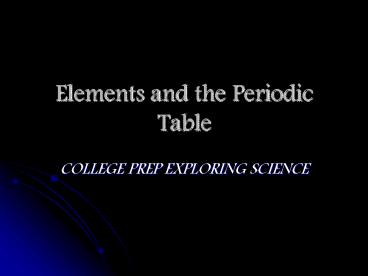Elements and the Periodic Table - PowerPoint PPT Presentation
1 / 17
Title:
Elements and the Periodic Table
Description:
Use a different color for each of the items below. Metals Alkali Metals Alkaline Earth Metals Transition Metals Metalloids Nonmetals Halogens Noble Gases 5.1 ... – PowerPoint PPT presentation
Number of Views:132
Avg rating:3.0/5.0
Title: Elements and the Periodic Table
1
Elements and the Periodic Table
- COLLEGE PREP EXPLORING SCIENCE
2
The Modern Periodic Table - Journal
- What happens to properties when you move from
left to right across the table? - What type of elements are in yellow? In green? In
blue? - What is an important fact about the Actinide
series?
3
The Modern Periodic Table
- PROPERTIES ARE GROUPED BY COLUMNS
- Example - Group (Family 1) Alkali Metals
- What is similar?
4
The Modern Periodic Table
- HOW CAN WE CLASSIFY ELEMENTS?
- State solid, liquid, gas
- Natural manmade (91 of the first 92 are
natural) - METALS, NONMETALS METALLOIDS
5
PROPERTIES
- METALS
- Mostly solid,
- Good conductors of electricity and heat
- METALLOIDS
- All solids
- Properties between metals and nonmetals
- Known as semi-conductors
- NONMETALS
- Solids, liquids and gases
- Good insulators
6
The Modern Periodic Table
Classified by Properties
What happens to properties when you move from
left to right across the table?
ELEMENTS BECOME LESS METALLIC AND MORE
NON-METALLIC
7
Representative Groups
- Elements in a group have SIMILAR (not identical)
PROPERTIES because they have the same number of
valence electrons
8
Representative Groups
- ALKALI METALS (group 1)
- Single valence electron
- EXTREMELY REACTIVE
- Reactivity increases from
- top to bottom
- It is not a metal, but Hydrogen is
- grouped here. Why?
9
Representative Groups
- ALKALINE EARTH METALS (group 2)
- TWO valence electrons
- Less reactive than group 1
10
Representative Groups
- BORON FAMILY (group 3A)
- THREE valence electrons
- FYI- Aluminum is the most
- abundant metal in Earths crust
11
Representative Groups
- CARBON FAMILY (group 4A)
- FOUR valence electrons
- FYI- Except for water, most compounds in your
body contain Carbon.
12
Representative Groups
- NITROGEN FAMILY (group 5A)
- FIVE valence electrons
- FYI- Nitrogen and Phosphorous are used to make
fertilizers.
13
Representative Groups
- OXYGEN FAMILY (group 6A)
- SIX valence electrons
- FYI- Oxygen is the most abundant nonmetal in
Earths crust, and Ozone is another form of
oxygen.
14
Representative Groups
- THE HALOGENS (group 7A)
- SEVEN valence electrons
- EXTREMELY REACTIVE
- Reactivity increases from bottom to top
- FYI- Halogen means salt former.
15
Representative Groups
- THE NOBLE GASES (group 8A)
- EIGHT valence electrons
- INERT (dont react easily)
- FYI- make neon lights when a current is passed
thru them.
16
Journal
- Color in the Periodic Table given to you and
color it in according to the following LIST. - Use a different color for each of the items
below. - Metals
- Alkali Metals
- Alkaline Earth Metals
- Transition Metals
- Metalloids
- Nonmetals
- Halogens
- Noble Gases
17
5.1 Journal
- Check your Periodic Table































